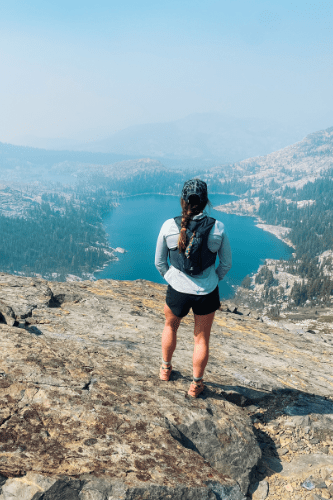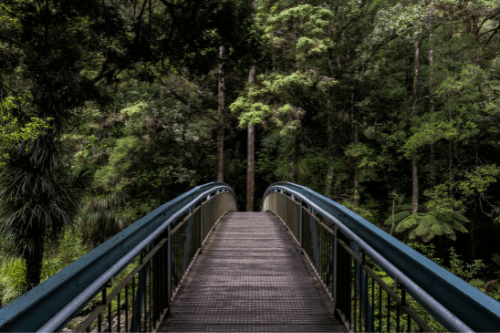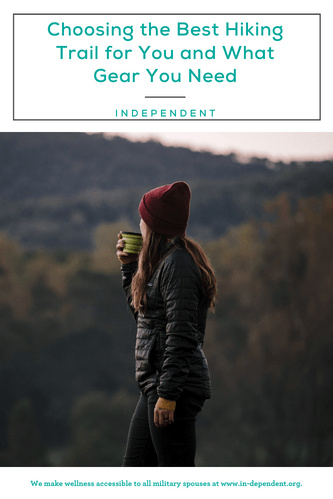
There are THOUSANDS of hiking trails in the United States alone. Which is remarkable and an incredible way to get outside. However, with THAT many options, it can feel overwhelming, especially if you are new(er) to hiking.

How far should I go? Is the trail hard? Where do I park? How do I get there? Is the trail even open? Are there restrooms? Can the kids handle it? These are likely questions circulating in your adventure-ready brain.
So, let’s not waste any more time. Let’s get into it! Here are some hiking basics to get you out there confidently and well-equipped.
HIKING BASICS
First things first. Here is a quick shakedown of day hiking basics:
-
Food and water: ALWAYS ensure you bring plenty of snacks and water in your day pack, fanny pack, or backpack when heading out for a hike. You can carry water in a water bladder compatible with your day pack (hands-free option) or bring a traditional water bottle like a Nalgene. And snacks—bring more snacks than you think you will need. Especially if you have littles as this can make or break a hike!


- Here is a list of easy and tasty trail snacks for adults and kiddos. If you plan to be out there for longer, have no fear. Here is another list of no-cook hiking lunch options, because there is no greater feeling than knowing you have a tasty wrap (and a bag of potentially crumbled potato chips) waiting for you in your pack.
- Shoes and clothes: While trail runners and hiking boots are worth the investment and provide beneficial features like better grip, traction, and sturdiness, if you only have a comfortable pair of sneakers, wear those. Don’t let not having a “trail shoe” yet keep you from exploring! Despite what you may have read online, you don’t have to have “hiking-specific” clothes. If you have workout clothes, those are perfect to wear when hiking. The material is moisture-wicking and comfortable, which is what you are looking for. Avoid cotton because it does not dry quickly.
- More on the weather shortly, but the layers (sweatshirt, rain jacket, windbreaker, gloves, etc.) you will need to pack and bring are based on what Mother Nature decides she wants to do and the current season. Possible rain showers in April? Light rain jacket. Chilly mornings in November? Gloves and a hat.
- Weather: Double-check and then triple-check the weather! This pre-hike checklist item is imperative to ensure a safe time out there and to steer clear of nasty weather.
- Safety: Safety should always be the number one priority. This allows all recreators to have a blast, make long-lasting memories, and come home without a hitch. From practices like letting someone know where you are hiking to always carrying some form of identification, these tips can give you and your loved ones peace of mind.
CHOOSING A HIKING TRAIL
Okay—now on to the fun stuff—choosing a hiking trail! Start by going to the app store on your phone and downloading AllTrails. They offer both a free and a premium version. The free version is fantastic and will get the job done. Once you’ve made an account, there are a few things to consider when narrowing down which hiking trail is best for you:
- Drive time: For your hike, do you want to stay close to home, or do you have time to take a mini road trip to get to the trailhead? Your answer to this question will determine what city you type into the search bar: the one you live in or one that’s a couple of hours away.

- Distance of the trail: After choosing your destination city, browse through the options listed and find one with the total mileage you’re comfortable doing. General rule of thumb—if you are a beginner, choosing a round-trip hike that’s two to three total miles in length is a solid place to start. If you are more experienced or have a high fitness level, opt for a four to six or more-mile hike. And if you have kiddos, one to one and a half miles should be a great mileage goal for their little legs.
The AllTrails app has a filter function allowing for adjusting your search based on length, difficulty, and elevation gain. This helps narrow things down!
- Terrain and elevation: Check out the terrain and elevation once you’ve found a few trails that have the distance you are looking for. The terrain will consist of what’s on the trail like rocks, sand, roots, gravel, river crossings, giant boulders, bridges, etc. The elevation is the total amount, commonly measured in feet, you will climb (go up) while completing the hike. There will always be a description, and other AllTrails app users leave photos and comments you can read and browse through. The description is where you can see how much elevation gain to expect.

For beginner hikers, you may want to find a trail that has less than 500 feet of elevation gain to start. As you hike more and become more comfortable, you can opt for more challenging elevation hikes and technical terrain!
- Time on the trail: Lastly, knowing how much time you have to hike is essential when choosing because the total mileage will determine how long you will be spending out there. Another general rule of thumb, the estimated time to complete a mile for an easier and low elevation gain trail is around twenty minutes. You will be looking at twenty-five to thirty minutes per mile for a more technical route with a more significant elevation gain. Don’t forget to account for snacks and rest breaks into your total time! Those are the BEST parts. Your fitness level and experience will dictate your pace, and it’s perfectly okay if you aren’t “fast!” YOU get to choose your speed and do what is most comfortable for YOU.
A LITTLE MORE ADVICE
When hiking, reference the map via the app to navigate the correct route. It’s good practice to bring a hard copy map in case you lose service, or your phone takes an involuntary dip in the pond! The park’s office or Ranger Station should have maps available. Snap a photo of the map at the trailhead if you can’t get your hands on a hard copy.

The more information you can gather about the trail, the better. Google and YouTube will be other great resources for blogs and videos about where you plan to hike, further allowing you to learn about trail conditions, wildlife, common weather patterns, parking, bathroom accessibility, permits/fees, trail markers (signage, arrows, spray-painted trees, cairns, etc.), and everything in between. OR you can reverse engineer by searching “Best Hikes in Seattle” and plugging those trail names into the AllTrails app, checking out what they look like and if they fit your skill level, desires, and adventure vision!
One last thing before you are on your way…
There is no minimum requirement or distance to get started hiking or call yourself a hiker. You can start as small or as short as you are comfortable with. If a one-mile hike feels good for you to start, go out and do that mile and BE PROUD.

Okay, I lied… ONE more thing… You don’t always have to go on big and epic Instagram-worthy hikes for them to “count.” Any time you spend in nature and on the trail is worth celebrating, sharing, and being excited about. These still epic but smaller adventures are called micro-adventures. Micro-adventures are mini-adventures (in this case hikes). And more specifically, adventures and hikes that you can do close to home, which makes for great accessibility – weekend warrior style or even hike-after-work style.
Don’t get me wrong; the big adventures or hikes are incredible and genuinely epic, BUT what about the small adventures that are more doable for the average busy human and family? The ones that can be experienced as little as an hour away or as close as a local park?
Yeah, those. Those are wonderful and excitement-worthy too.

ABOUT BETHANY

Bethany Taylor is a freelance writer, Milspouse, ultra-runner, nutritionist, all-women adventure trip host, and entrepreneur. She is based out of Memphis but will be moving to Japan in the fall of 2022. If you can’t find her waking up in a sleeping bag or with a pair of muddy trail runners on, you can catch her talking to her dog, lifting, mountain biking, trail running, fly fishing, hiking, eating snacks, or drinking espresso.

